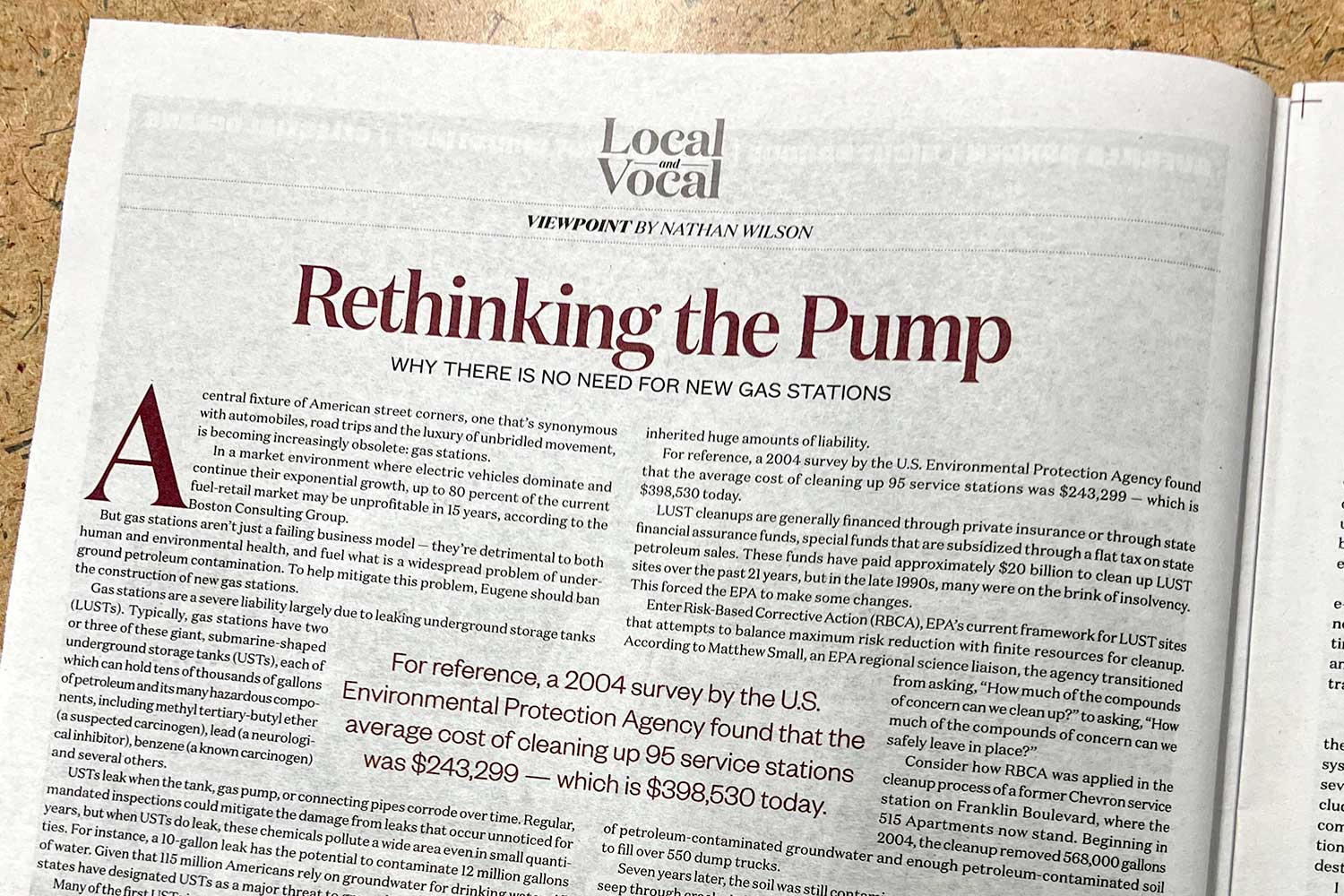by Nathan Wilson
A central fixture of American street corners, one that’s synonymous with automobiles, road trips and the luxury of unbridled movement, is becoming increasingly obsolete: gas stations.
In a market environment where electric vehicles dominate and continue their exponential growth, up to 80 percent of the current fuel-retail market may be unprofitable in 15 years, according to the Boston Consulting Group.
But gas stations aren’t just a failing business model — they’re detrimental to both human and environmental health, and fuel what is a widespread problem of underground petroleum contamination. To help mitigate this problem, Eugene should ban the construction of new gas stations.
Gas stations are a severe liability largely due to leaking underground storage tanks (LUSTs). Typically, gas stations have two or three of these giant, submarine-shaped underground storage tanks (USTs), each of which can hold tens of thousands of gallons of petroleum and its many hazardous components, including methyl tertiary-butyl ether (a suspected carcinogen), lead (a neurological inhibitor), benzene (a known carcinogen) and several others.
USTs leak when the tank, gas pump, or connecting pipes corrode over time. Regular, mandated inspections could mitigate the damage from leaks that occur unnoticed for years, but when USTs do leak, these chemicals pollute a wide area even in small quantities. For instance, a 10-gallon leak has the potential to contaminate 12 million gallons of water. Given that 115 million Americans rely on groundwater for drinking water, 45 states have designated USTs as a major threat to groundwater quality.
Many of the first USTs in America were established after World War II, but there was one issue: these USTs were made from unprotected steel, as opposed to the modern fiberglass equivalent, making them extremely prone to developing holes through oxidation. Big Oil understood this as early as the 1930s, but rather than addressing it, the industry programmatically disinvested from UST systems in the late 1970s and early 1980s.
Around that same time, the federal government started implementing regulations through the Comprehensive Environmental Response, Compensation and Liability Act as well as the Resource Conservation and Recovery Act. Since USTs had been slowly leaking for decades, however, the small business owners who acquired these systems inherited huge amounts of liability.
For reference, a 2004 survey by the U.S. Environmental Protection Agency found that the average cost of cleaning up 95 service stations was $243,299 — which is $398,530 today.
LUST cleanups are generally financed through private insurance or through state financial assurance funds, special funds that are subsidized through a flat tax on state petroleum sales. These funds have paid approximately $20 billion to clean up LUST sites over the past 21 years, but in the late 1990s, many were on the brink of insolvency. This forced the EPA to make some changes.
Enter Risk-Based Corrective Action (RBCA), EPA’s current framework for LUST sites that attempts to balance maximum risk reduction with finite resources for cleanup. According to Matthew Small, an EPA regional science liaison, the agency transitioned from asking, “How much of the compounds of concern can we clean up?” to asking, “How much of the compounds of concern can we safely leave in place?”
Consider how RBCA was applied in the cleanup process of a former Chevron service station on Franklin Boulevard, where the 515 Apartments now stand. Beginning in 2004, the cleanup removed 568,000 gallons of petroleum-contaminated groundwater and enough petroleum-contaminated soil to fill over 550 dump trucks.
Seven years later, the soil was still contaminated enough that chemical vapors could seep through cracks in building foundations and pollute indoor air. To avoid that risk without continuing remediation, the Oregon Department of Environmental Quality prohibited residential use on the first floor of the 515 Apartments.
Out of the 570,964 confirmed releases from USTs nationwide, 58,483 LUST sites still require cleanup, including 114 active cleanups in Lane County that will likely leave some contamination in place due to RBCA.
Underground petroleum contamination is a widespread problem caused by corporate neglect that has been routinely mismanaged to the detriment of communal safety and environmental sanctity. The first of many steps that should be taken to address this problem is banning the construction of new gas stations. To support a clean energy transition, testify for a moratorium on new gas stations when Eugene City Council votes on the proposal this fall.
Nathan Wilson is a journalism student at University of Oregon currently interning at Beyond Toxics.
